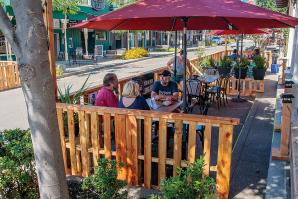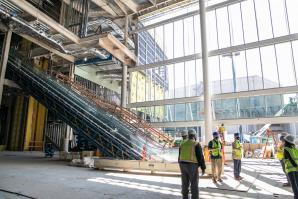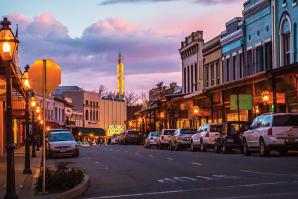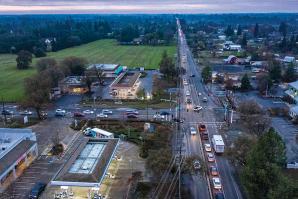Elaine Andersen was appointed Folsom city manager in July 2018 after 13 years working for the local municipality in other positions. She moved to Folsom 30 years ago, when the city had a population of nearly 30,000; now about 80,000 people live there. The Folsom Plan Area, which is now under development, will add housing, schools, parks, and commercial and office buildings, and bring in an estimated 25,000 new residents. Comstock’s spoke to Andersen about changes underway.
What are some of the major ways you’ve seen your community change during your time living and working in Folsom?
We got a little apartment 30 years ago, and that was our start here. We bought our first home in 1996 (in) Folsom, and now we’re in our second home where we’ve raised our children. … When we first got here, we would leave Folsom for really serious shopping … (and) go down to Sacramento. If we wanted high-level entertainment or dining, we would leave Folsom.
Fast forward to today, thanks to some really wise planning by some great leaders over the years, we can’t find a whole lot of reasons to leave. We now have a world-class performing arts center called the Harris Center that’s part of Folsom (Lake) College. We have amazing employers, like Intel. We have … high-tech and health care hub(s) here. We have amazing restaurants. We have the Palladio, which is full of great and interesting shops, and our Broadstone Marketplace, our central business district, (and) the historic district. So what has changed is there’s even more to offer, and yet it’s all still contained within a wonderful small-town feel.
What, if anything, does Folsom need to do to attract new residents?
We’ve done a great job of attracting people here. … We have 48 parks. We have miles of trails. We have beautiful natural amenities. We are now developing south of (Highway) 50 … and we’re trying to make sure we continue to offer what we call the “95630 experience.” … What we need to do more of is what brought us to that point, and that was careful, wise land-use planning that makes sure we have the perfect and right blend of natural amenities, accessing them through trails and parks, homes, shops and businesses, high-level employers that keep people here.
The events of 2020 have definitely created a cultural shift in how people work and live. … The highly talented workforce in the Bay Area is at a critical juncture in terms of the high cost of living in the Bay Area in conjunction with now people have a choice in terms of their workplace flexibility. This creates an opportunity for places like Folsom to showcase what we have here in terms of our quality of life paired with a dynamic business culture, so that’s kind of an interesting angle for us for the future.
We (launched) #WeSupportFolsom, a campaign to encourage shopping and dining locally and why it’s more important than ever to do that. … We want to be sure people know that when you shop local, it pays off for all of us in terms of the amenities we can provide.
We work as the city in very close partnership with the Greater Folsom Partnership, which encompasses our Folsom Chamber of Commerce, and (we) are working with them to spearhead two campaigns. One is a campaign called: Folsom, the Best Kept Secret in Northern California. It’s a multimedia campaign that basically highlights the pillars of the Folsom brand message, which is the abundant recreational amenities, outstanding educational system — we’re a full-service city: We have our own fire department, our own police department and a high concentration of tech jobs. We (launched) #WeSupportFolsom, a campaign to encourage shopping and dining locally and why it’s more important than ever to do that for local businesses. We want to be sure people know that when you shop local, it pays off for all of us in terms of the amenities we can provide.
Has sales tax revenue in Folsom taken a hit with the pandemic, and what does that mean for city services?
Cities depend primarily on three sources of revenue to provide the services. … Those are property tax revenue, which is doing fine for us, because this is still (a place where) people very much want to live, and home values are holding strong and increasing. (Another source is) programming revenues, which is the money that comes from people using our services like signing up their kids for a parks and recreation program or swimming at the (Steve Miklos) Aquatic Center. … Early on, I had to turn off the spigot on literally so many programs, and that means critical revenues just disappeared. Now, thankfully, we’ve been able to bring some things back. But, of course, nothing looks the same right now. So, yes, we brought back some recreation classes, and we’ve opened our aquatic center again, and we’re slowly bringing some of that money back. But we can’t have (as) many people in the classes … that impacts revenue.
The third source is sales tax revenue. People are purchasing … but they’re doing it in a very different way. … People are tending to go into stores with a single-minded purpose, especially in the early days of the pandemic, and they’re just getting the things they need, and they’re exiting as opposed to the more leisurely wandering around the store that results in some nice impulse buying that helps out businesses. There’s also been a big shift to online purchasing. Although the city does get a piece of that depending on some pretty complex formulas, it can impact us adversely.
So, yes, we have seen a decrease in our sales tax. What that means is … I had to tell (the department heads who oversee) half of our temporary workforce — folks that just have temporary jobs (who) pick up hours here and there — we can’t have that right now. It means I am pushing off major capital purchases, like vehicles. … I was offered and turned down a salary increase. I did not offer salary increases to any of my department heads this year. … We’re in a very careful mode right now, and we’re definitely in a wait-and-see mode.
How has the pandemic accelerated or hampered efforts to attract new business and industry?
The pandemic is opening up our opportunities, particularly with companies who are telling employees, “You can live wherever you want to live.” … (In terms of development) south of (Highway) 50, there are some really interesting and exciting things happening over there, including Dignity Health has just announced they’re going to start on first a medical office building and, in the future, a hospital on a 28-acre site, and that will have a huge economic multiplier effect in terms of the jobs it brings in and people (who) want to live here and be close to that, and how up and down the corridor people will be in full support because they will be accessing great health resources.
Major development is happening south of Highway 50. Can you give me an overview of what’s going on now?
This is decades and decades and decades of leaders working together in a wise fashion to make this happen. … Folsom Ranch is how we refer to most of (the development), and it’s part of a 3,500-acre Folsom Plan Area south of 50 between Highway 50 and White Rock Road, and it’s bordered by the El Dorado County line on the east and Prairie City Road on the west. The eventual buildout of the plan includes 1,000 acres of open space, which is pretty extraordinary; 130 acres of parks; 30 miles of trails that will connect to our already extensive trail system; 500 acres of oak woodlands. …
We’re going to have schools, a transit corridor, and we think there will be about 8,000 new jobs generated because of the project. Those homes are selling spectacularly well. We’ve already sold close to 700 homes (out of a planned 11,000 total). … Mangini Ranch Elementary School — the school district already broke ground — will be the first school in that community. … It’s designed to accommodate close to 700 students, kindergarten through fifth grade, and it’s going to be open (this) year, and it’s immediately adjacent to a park site. … That’s a very common model of an elementary school sited right next to a city park. … We have 10 builders out there, and you do see that real mix of housing type, so it’s not cookie cutter at all.
Most of the Capital Region is dealing with a housing crisis. How is Folsom when it comes to having enough housing inventory and, specifically, affordable housing?
We’re very committed to providing affordable housing in Folsom and meeting our affordable housing target. We’re well on the way to doing so. We have several apartment construction projects underway. There are four market-rate (apartment) projects under construction, and there’s one proposal pending. We also have one affordable apartment project under construction, another one recently approved and two proposals pending. In July (2019), our city council approved and adopted what’s called an accessory dwelling unit ordinance, and that’s consistent with state laws. … They’re essentially like what you think of as granny flats, and that’s intended to provide another affordable opportunity, hopefully, for people who are looking for housing. We’re continuing progress in terms of working with our city council to identify different areas to allow different densities and opportunities to create more affordable housing opportunities. …
The city has 751 existing affordable-housing units receiving government assistance. In addition, (upcoming) projects are planned, including 291 units. … We continue to pursue mostly state-level funding opportunities to try to build as much affordable housing and/or convert as much affordable housing as we can.
Edited for length and clarity.
–
Tell us what you want to see in Comstock’s: Take our reader feedback survey and be entered to win a $100 gift card.
Recommended For You

Resetting in Historic Folsom
The return of dining is important to the vitality of Sutter Street — but challenges exist
Folsom’s Sutter Street banks on its dining options to draw foot traffic. Now, the community is working to lift restaurants out of record-breaking lows.

Encouraging Signs
Visit Sacramento’s Kari Miskit on how the organization is helping the tourism and hospitality industry stay afloat
In a world where travel is suddenly not only difficult but also potentially dangerous, a group dedicated to increasing tourism in the Capital Region has to be creative.

Small Downtowns Blend History With Unique Experiences
The Capital Region offers a mix of destinations within an hour’s drive of Sacramento
For anyone in the Sacramento area looking to get away for a day or weekend, the Capital Region has plenty of hidden gems — the many downtowns in rural enclaves that are easy to drive to and explore by foot.

Making Connections
As more people move farther out, options are in the works to ease their commutes
Stitching together rural and suburban areas from near the Delta to the foothills, Grant Line Road and White Rock Road connect the area’s past and future.





Comments
(1) Please advise when the traffic problem will be fixed on the south end of east bidwell. The intersection of Iron point, In-and-out burgers, costco, Whole Foods shoping, Sam Club, etc...makes a huge traffic mess!
(2) With the closing of several larger store operations, "steinmart" and many small business, is Folsom's focus on leasing the "dark store frounts" or on the new develeopments?